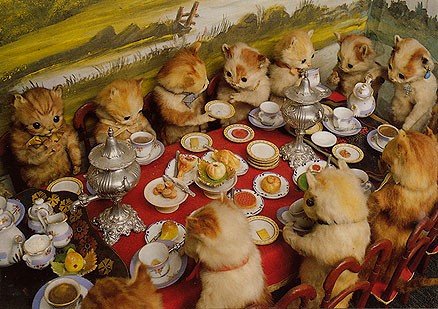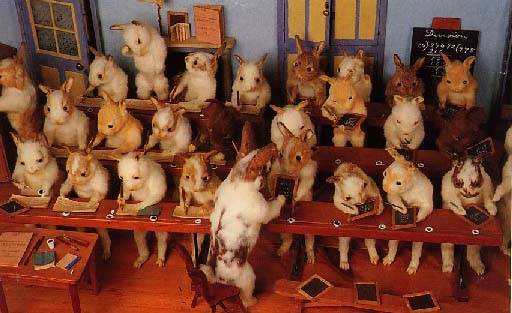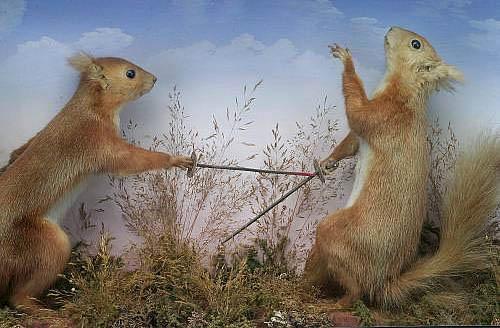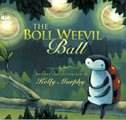
The Kitten's Tea Party

Rabbits in a Sussex School

The Death

Kitten's Wedding
Horrified yet? I can't stop looking at all of his taxidermy scenes. I keep going between a girls squeal of cuteness to a gastly shriek of horror. Regardless, it prompted me to discover more about this Potter fellow.
Walter Potter was born in 1835 and began to experiment with taxidermy by the age of 15, preserving the body of a pet canary. His family ran the White Lion (now the Castle) in Bramber, West Sussex England, and as he expanded his experiments in preservation, he was obliged to move to the stable loft. This was the time of the Great Exhibition and one of the attractions was much to the taste of the Victorians, Hermann Ploucquet's display of taxidermy. The Comical Creatures from Wurtemberg showed stuffed animals in human situations. They were so popular that a book of hand-colored engravings of them was published. There is no way of knowing whether young Walter Potter saw the exhibition or the book, but his growing interest in taxidermy was clearly much in tune with popular taste.
By the age of 19, he had produced 98 stuffed birds which made up the first of the tableaux for which he became well known. This was "The Original Death and Burial of Cock Robin", inspired by a book of stories belonging to his younger sister. Within the large glass case was displayed the sorrowful funeral procession of Cock Robin together with the Sparrow who killed him with his bow and arrow, Parson Rook and the Owl who dug the grave, accompanied by the mourners, all of whom made their way through the graveyard.
The tableau was an immediate success with the customers of the White Lion when it was first displayed in a summer house behind the inn in the summer of 1861. This success launched young Walter on a career preparing stuffed animals for Victorian parlours, but he continued to produce the more creative tableaux. Taxidermy was used by the Victorians to study and understand animals and their physiology. In the late 1800s, it was thought fashionable to have deceased pets stuffed and cased, or mounted, and on display. Since there were no cinemas, and photography was very basic, it also allowed many people to see wild and exotic animals that they may not have seen before, or perhaps again.
Potter's growing stock meant a move to new premises in 1866 and again in 1880 to the specially constructed building still in Bramber today. By then the collection was termed a 'museum' and the tableaux of small animals and birds had been joined by the likes of the two-headed lambs and four-legged chickens which fascinated later generations of children. ARGH!
Where did Waiter obtain the large number of animals he used in the displays? We know that he had an arrangement with Ward's Farm in Henfield to take over their continuous supply of unwanted kittens produced by the farm cats, and his growing reputation locally meant that the public brought him items of interest. Potter suffered a stroke in 1914 and never fully recovered, passing away in 1918. His collection was kept by his daughter, Minnie Collins, who eventually sold it. The collection changed hands and moved around England several times before being broken up into separate lots when it was auctioned off in 2003.
Sad, in a way, but there is the Walter Potter Foundation which is dedicated to the ultimate goal of returning all of the important Walter Potter taxidermy tableaux and relevant artifacts to England for permanent public display and to educating the public about this important body of work. I think I would just have to go to West Sussex to see it. Holy heebeegeebee trip.
On a sidenote, currently living in Chicago, Jessica Joslin's work, though slightly different, is also extremely astounding.





2 comments:
I bet they ponged a bit!
Taxidermy is weirdly fascinating isn't it? In the Bristol Museum we have a whole section of stuffed animals thanks to the Victorians,(not holding a banquet though!) It's always the most popular room.
Holy crap!
Not sure WHAT I think of this, but it sure is intriguing.
Thanks for sharing, I think!
Post a Comment